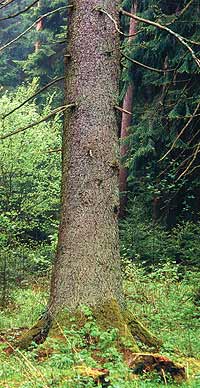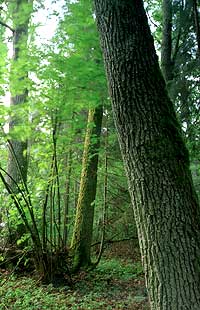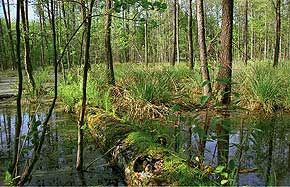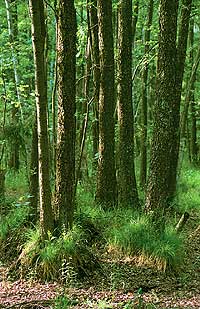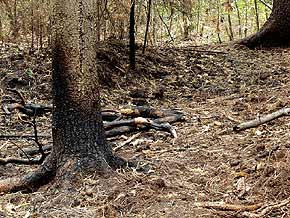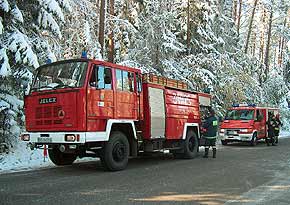|
15th |
WIGRY NATIONAL PARK
|
|||||||
|
of "WIGRY"
|
Zbigniew Bogusławski
Forests and their surroundings
The area of the Wigry National Park’s forests is 9,464 hectares, i.e. 63% of its total area. Various topographic features, differentiation of soil fertility and moisture cause that nearly all forest communities typical of north-eastern Poland can be found in the Park. The habitats north and west of Lake Wigry are characterised by better fertility, however, south and east of the lake there are poorer habitats changing into a sandy sandr of the Augustowska Plain.
Dry-ground forests are the most often found communities. About 60% of the forest area is occupied by a plant assemblage of a subcontinental dry-ground forest Tilo Carpinetum. Under natural conditions the vegetation composition of the assemblage is rich and variable. The following species can be found here, among others: the English oak (Quercus robur), the common spruce Picea abies, the small-leaf lime Tilia cordata, the pine Pinus silvestris, and also the Norway maple Acer platanoides, the verrucose birch Betula pendula, the aspen Populus tremula, the European ash Fraxinus excelsior, the wych elm Ulmus glabra, and many species of shrubs. Human activity over the last few centuries has caused that the species composition of dry-ground forests has become poorer. Broadleaf species have been cut, and the pine and spruce have mainly been introduced in their place.
At present, the pine occupies 80% of the Park’s area, and the spruce 12%. The average age of forests in the Park is 69 years. The youngest tree-stands, under 20, occupy 8.5% of the forest area, and the oldest ones, over 100, cover about 32% of the area. The forests in the Wigry National Park reconcile the function of nature conservation with a tourist use. There are areas where tourists are allowed, as well as areas excluded from any kind of man’s presence. Until the establishment of the Wigry National Park the forests had mainly been used for timber production. The establishment of the Park meant implementation of new conservation goals, and the need to reconstruct forests. In the period of the last 15 years, protective measures in the area of about 650 hectares of tree-stands have been carried out. In the years 1994–1999, the spruce bark beetle gradation was the main cause of loss in tree-stands. Gaps in the tree-stands appeared also in other periods as a result of strong winds and tree dieback in the focus of fungal diseases.
The forest is a living environment for many animal species, but excessive amounts of certain species have a significant influence on species composition and the quality of plant assemblages. Roe-deer, deer and elks damage and destroy seedlings and young trees through predation. Various protective measures are taken to limit this. They consist in protection of particularly valuable elements of tree-stands against game.
The reduction in a negative influence of forest cambiophage insects, mainly bark beetles, on the environment is an important task in forest conservation. It has been done through putting out traps. The presence of large quantities of dead wood, which causes an increase in biological diversity, is an important feature of a natural forest. A lot of trees are left every year to this end.
Large forest areas are usually accompanied by bigger or smaller deforested areas. Some of them are a result of natural factors, such as a hurricane or mass occurrence of insects. Some of them are man-made.
These areas are an important link in natural succession of arborescent vegetation, and, moreover, they are characterised by a different species composition from the one in forest areas. Many rare plant and animal species, which have become extinct in farmed areas, are found here, for example many species of orchids, and also a numerous group of invertebrates.
Active protection measures are carried out here, which makes it possible to preserve the existing vegetation structures.
All the measures used in forests and unforested ecosystems are subordinated to the goals of conservation of the Park’s land environment. They are performed according to the guidelines in the Conservation Plan, which defines their kind and range in a complex way, in accordance with the present knowledge. The primary goal is to restore the natural condition of forests by Lake Wigry. Thanks to that it will be possible to admire the nature of the Wigry National Park in an even more attractive and enriched form.
Piotr Pieczyński
Fire protection of forest areas in the Wigry National Park
Most fires which have been recorded in the WNP had a surface character. Majority of them appeared during the highest degree of fire hazard when temperatures were high, which caused the leaf litter and forest floor plants to dry. The most dangerous fire occurred in 1994 in the protective Circuit of Krusznik. When the firefighters arrived, the larch crop and 120-year-old pine trees had already been on fire. Fortunately, the firefighters were able to stop the blaze from spreading.
Forest fires are most often caused by people relaxing in the forest. They are most often triggered off unintentionally or are caused by people neglecting fire safety regulations, but as many as 24% of fires are a result of arson. Thus, it seems that the best way to limit the number of forest fires is to raise social awareness through appropriate informational and propaganda campaigns and making visitors to national parks aware of how dangerous a forest fire can be. The Wigry National Park organizes such actions. We give out in schools and to the public materials connected with fire protection; these are various kinds of leaflets and posters in which we appeal to people’s common sense and ask for observing of the safety regulations in and around the forest. In 2002, the Director of the WNP set up the Park’s Fire Protection Service. It is a group of 8 people, Park Service staff, having the knowledge of fighting forest fires and equipped in rescue and fire extinguishing equipment (a fire engine, etc.)
|
|||||||
|
|
|
